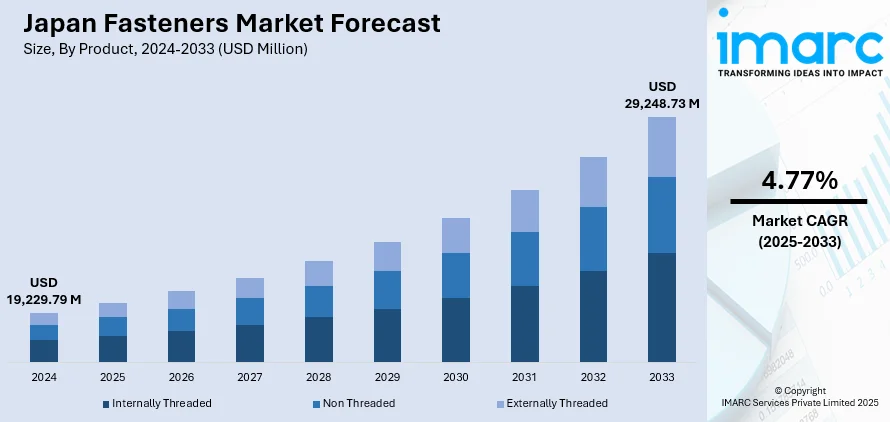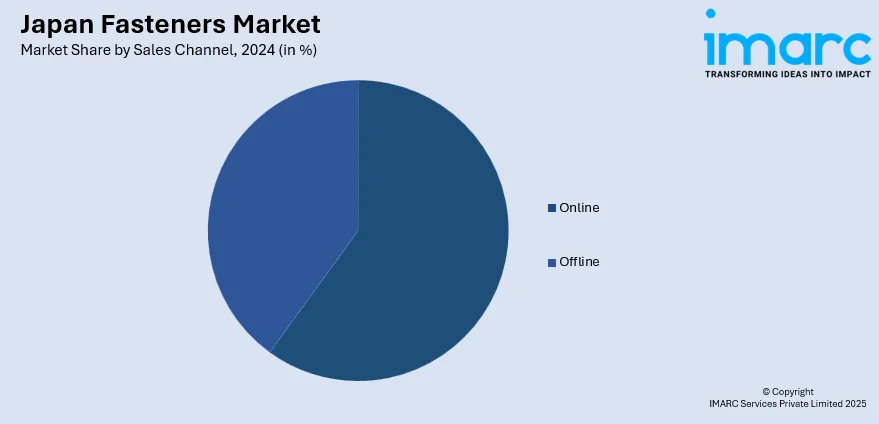
Japan Fasteners Market Size, Share, Trends and Forecast by Product, Sales Channel, End Use, and Region, 2025-2033
Japan Fasteners Market Overview:
The Japan fasteners market size reached USD 19,229.79 Million in 20244. Looking forward, IMARC Group expects the market to reach USD 29,248.73 Million by 2033, exhibiting a growth rate (CAGR) of 4.77% during 2025-2033. Robust automotive and electronics manufacturing, rising demand for precision-engineered components, infrastructure modernization, and export-oriented industrial output are some of the factors contributing to Japan fasteners market share. Growth in the renewable energy and construction sectors further supports fastener consumption across diverse mechanical and structural applications.
|
Report Attribute
|
Key Statistics
|
|---|---|
|
Base Year
|
2024
|
|
Forecast Years
|
2025-2033
|
|
Historical Years
|
2019-2024
|
| Market Size in 2024 | USD 19,229.79 Million |
| Market Forecast in 2033 | USD 29,248.73 Million |
| Market Growth Rate 2025-2033 | 4.77% |
Japan Fasteners Market Trends:
Rising Global Preference for Precision-Engineered Fasteners
The Japan fasteners market is increasingly defined by its scale, quality, and standardization. A growing network of local manufacturing partnerships is enabling the production of an exceptionally wide range of fasteners, often exceeding millions of distinct types. Strict adherence to Japanese Industrial Standards ensures consistency and reliability, particularly vital for demanding sectors like automotive and electronics. Digital integration in logistics and inventory systems is improving supply chain efficiency, supporting both local manufacturers and international buyers. As a result, Japanese fasteners are seeing greater adoption worldwide, with rising demand for products that meet tight tolerances and performance specifications. This momentum continues to strengthen Japan’s export capabilities and reinforces its image as a dependable hub for high-precision mechanical components. These factors are intensifying the Japan fasteners market growth. For example, in May 2024, SUNCO Industries collaborated with around 1,300 domestic manufacturers to supply over 2 Million types of fasteners, reinforcing Japan’s position in the global fasteners market. With a strong focus on Japanese Industrial Standards, digital logistics, and precision quality, the company supports key sectors like automotive and electronics, driving consistent domestic demand and export growth for high-performance fastening solutions across international markets.

Expanding Overseas Manufacturing Ties to Strengthen Market Reach
Japan’s fasteners industry is deepening its global integration through collaborative manufacturing efforts in emerging markets. By establishing production bases abroad, especially in large automotive economies like India, Japanese manufacturers are boosting their responsiveness to local demand while also supporting global supply chains. These ventures enable greater localization of engineering and production capabilities, helping maintain quality standards while lowering lead times. Such strategic moves enhance competitiveness in cost-sensitive markets without compromising on precision or performance. The growing emphasis on bilateral technical cooperation also facilitates knowledge exchange and access to advanced manufacturing processes. This approach is reinforcing Japan’s role not just as a supplier of high-quality fasteners but also as a long-term partner in international industrial development. For instance, in June 2024, Japan’s Mitsuchi Corporation signed an MoU with Super Screws Pvt Ltd to establish a cold forged parts manufacturing joint venture in India. The initiative targets both domestic demand and global exports, strengthening Japan’s fastener footprint. Mitsuchi brings advanced technical expertise, supporting engineering localization and reinforcing Japan’s competitive position in India’s growing automotive fasteners market.
Japan Fasteners Market Segmentation:
IMARC Group provides an analysis of the key trends in each segment of the market, along with forecasts at the region level for 2025-2033. Our report has categorized the market based on product, sales channel, and end use.
Product Insights:
- Internally Threaded
- Non Threaded
- Externally Threaded
The report has provided a detailed breakup and analysis of the market based on the product. This includes internally threaded, non threaded, and externally threaded.
Sales Channel Insights:

- Online
- Offline
A detailed breakup and analysis of the market based on the sales channel have also been provided in the report. This includes online and offline.
End Use Insights:
- Automotive
- Building and Construction
- Aerospace
- Machinery
- Electronics
- Others
A detailed breakup and analysis of the market based on the end use have also been provided in the report. This includes automotive, building and construction, aerospace, machinery, electronics, and others.
Regional Insights:
- Kanto Region
- Kansai/Kinki Region
- Central/Chubu Region
- Kyushu-Okinawa Region
- Tohoku Region
- Chugoku Region
- Hokkaido Region
- Shikoku Region
The report has also provided a comprehensive analysis of all the major regional markets, which include Kanto Region, Kansai/Kinki Region, Central/Chubu Region, Kyushu-Okinawa Region, Tohoku Region, Chugoku Region, Hokkaido Region, and Shikoku Region.
Competitive Landscape:
The market research report has also provided a comprehensive analysis of the competitive landscape. Competitive analysis such as market structure, key player positioning, top winning strategies, competitive dashboard, and company evaluation quadrant has been covered in the report. Also, detailed profiles of all major companies have been provided.
Japan Fasteners Market News:
- In April 2025, Toyota launched the 2026 GR Yaris in Japan, introducing notable upgrades focused on performance and handling. The eight-speed GR Direct Automatic Transmission receives improved gear selection logic, quicker paddle shifts, and enhanced redline responsiveness. Chassis rigidity is increased with new fastening bolts, leading to retuned dampers for better stability and ride comfort. Steering has also been revised with track-tuned and road-focused variants offering distinct driving dynamics.
Japan Fasteners Market Report Coverage:
| Report Features | Details |
|---|---|
| Base Year of the Analysis | 2024 |
| Historical Period | 2019-2024 |
| Forecast Period | 2025-2033 |
| Units | Million USD |
| Scope of the Report |
Exploration of Historical Trends and Market Outlook, Industry Catalysts and Challenges, Segment-Wise Historical and Future Market Assessment:
|
| Products Covered | Internally Threaded, Non Threaded, Externally Threaded |
| Sales Channels Covered | Online, Offline |
| End Uses Covered | Automotive, Building and Construction, Aerospace, Machinery, Electronics, Others |
| Regions Covered | Kanto Region, Kansai/Kinki Region, Central/Chubu Region, Kyushu-Okinawa Region, Tohoku Region, Chugoku Region, Hokkaido Region, Shikoku Region |
| Customization Scope | 10% Free Customization |
| Post-Sale Analyst Support | 10-12 Weeks |
| Delivery Format | PDF and Excel through Email (We can also provide the editable version of the report in PPT/Word format on special request) |
Key Questions Answered in This Report:
- How has the Japan fasteners market performed so far and how will it perform in the coming years?
- What is the breakup of the Japan fasteners market on the basis of product?
- What is the breakup of the Japan fasteners market on the basis of sales channel?
- What is the breakup of the Japan fasteners market on the basis of end use?
- What is the breakup of the Japan fasteners market on the basis of region?
- What are the various stages in the value chain of the Japan fasteners market?
- What are the key driving factors and challenges in the Japan fasteners market?
- What is the structure of the Japan fasteners market and who are the key players?
- What is the degree of competition in the Japan fasteners market?
Key Benefits for Stakeholders:
- IMARC’s industry report offers a comprehensive quantitative analysis of various market segments, historical and current market trends, market forecasts, and dynamics of the Japan fasteners market from 2019-2033.
- The research report provides the latest information on the market drivers, challenges, and opportunities in the Japan fasteners market.
- Porter's five forces analysis assist stakeholders in assessing the impact of new entrants, competitive rivalry, supplier power, buyer power, and the threat of substitution. It helps stakeholders to analyze the level of competition within the Japan fasteners industry and its attractiveness.
- Competitive landscape allows stakeholders to understand their competitive environment and provides an insight into the current positions of key players in the market.
Need more help?
- Speak to our experienced analysts for insights on the current market scenarios.
- Include additional segments and countries to customize the report as per your requirement.
- Gain an unparalleled competitive advantage in your domain by understanding how to utilize the report and positively impacting your operations and revenue.
- For further assistance, please connect with our analysts.
 Request Customization
Request Customization
 Speak to an Analyst
Speak to an Analyst
 Request Brochure
Request Brochure
 Inquire Before Buying
Inquire Before Buying




.webp)




.webp)












